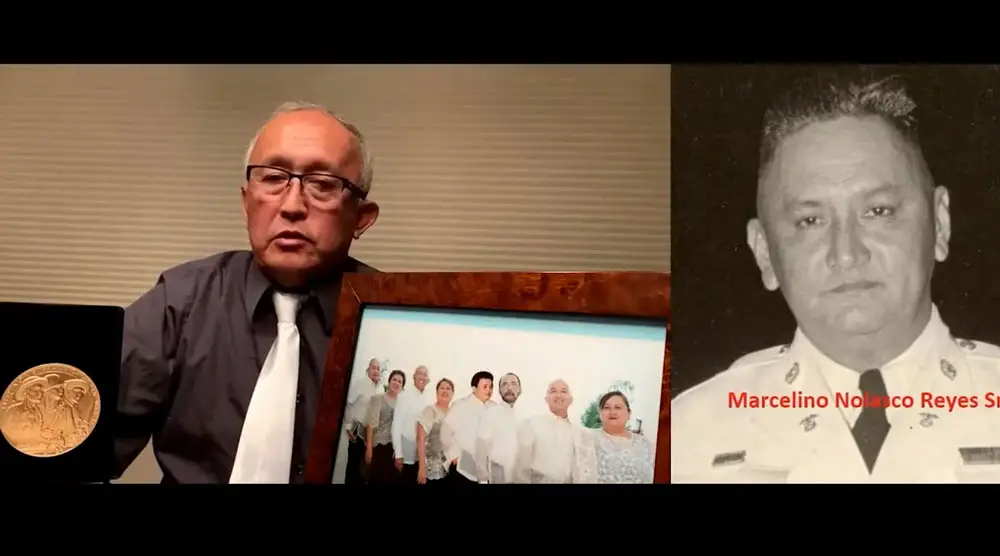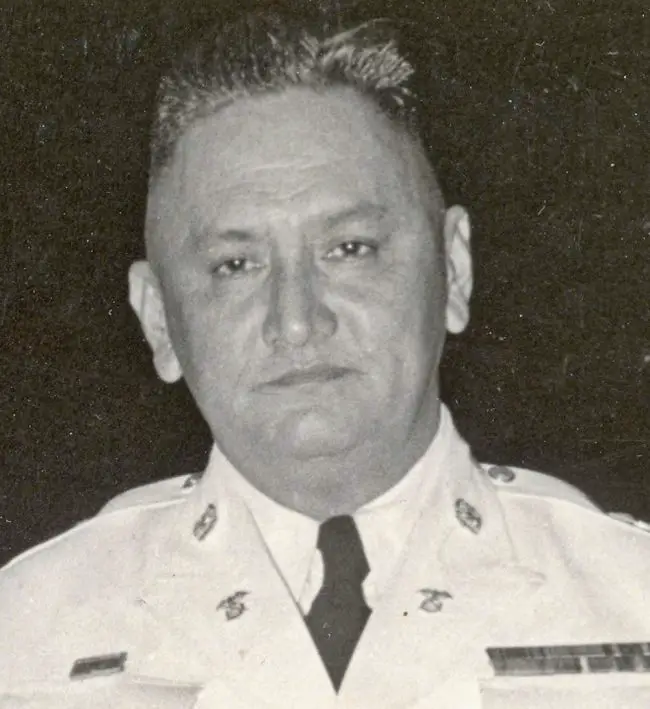
By Marcelino (Marc) Reyes Jr.
I am a 13-year resident of Palm Coast. Today, April 11, 2021, in a virtual award ceremony, I represented my family of eight siblings to accept the bronze replica of the Congressional Gold Medal on behalf of our departed father, Marcelino Reyes Sr., who served as a second lieutenant in the Philippine Commonwealth Army in the service of the U.S. Armed Forces during World War II.
He enlisted on December 17, 1941, a mere three weeks after his wedding and served with valor in the mountains of Mindanao and the beaches of Leyte.
In 2016, the 114th U.S. Congress enacted Public Law 114-265 awarding a Congressional Gold Medal, collectively, to the Filipino veterans of World War II in recognition of their outstanding wartime achievements and honorable service to the United States during World War II. The award honors more than 250,000 Filipinos who fought alongside American troops, including more than 57,000 who died. Filipino civilian deaths are estimated to range between 700,000 to upwards of 1 million, or nearly twice as many casualties as the combined American troop deaths on all fronts.
The Congressional Gold Medal is the highest civilian honor awarded in the United States.
On October 25, 2017, then-Speaker of the House Paul Ryan formally presented the Congressional Gold Medal to the Filipino veterans on Capitol Hill. They were given bronze replicas of the medal. Following the ceremony, the lone gold medal was taken to the Smithsonian Institution for display.
Since then, many more Filipino veterans or their next-of-kin have been presented the bronze replica in several award ceremonies in the United States and the Philippines. The virtual awards ceremony Sunday was part of the week-long 79th anniversary commemoration of the Bataan Death March. The ceremony featured the presentation of the bronze replica to 33 recipients.
The Philippines came into possession of the United States in 1898 after Commodore George Dewey defeated the Spanish Pacific navy in the Battle of Manila Bay during the Spanish-American War. In 1935, the United States established the Philippine Commonwealth. On July 1941, President Roosevelt issued orders calling the military forces of the Commonwealth into active service for the United States and assigned General Douglas MacArthur as commander of the U.S. Army Forces in the Far East.
On December 7, 1941, a day which President Roosevelt proclaimed as “a date which will live in infamy,” the Japanese Navy Air Service attacked Pearl Harbor. Less than 24 hours later, the Japanese Imperial Forces also attacked the Philippines. On April 9 1942, after the 3-month Battle of Bataan, the Japanese forced the transfer of 60,000–80,000 American and Filipino prisoners of war in the infamous 70-mile Bataan Death March. It was so brutal that it resulted in the estimated deaths of 6,000 to 10,000 Filipinos and nearly 700 Americans. The liberation of the Philippines started with the landing of General MacArthur in the beaches of Leyte on October 20, 1944.
As a commonwealth of the United States before and during the war, Filipinos were legally American nationals. With American nationality, Filipino veterans were promised all the benefits afforded to those serving in the armed forces of the United States. Sadly after the war ended, President Harry Truman signed the Rescission Act of 1946 which, among other provisions, stripped away promises of benefits and citizenship for Filipino veterans. Only recently have the veterans won back some concessions and recognition, including the Congressional Gold Medal.
The Filipino Veterans Recognition and Education Project (FilVetREP) was established in May 2013 to obtain national recognition of the Filipino World War II veterans and to launch a public information campaign on their experience and heroism. This project is headed by U.S. Army retired Major General Antonio M. Taguba as Chairman. “This is a day that is long, long overdue,” Ruan said at the October 2017 ceremony.
Today’s award ceremony was broadcast on YouTube and may be viewed below. The segment about Reyes begins here.
![]()
Congressional Gold Medal Ceremony commemorating the Bataan Memorial Death March:





























MITCH says
Thanks for his Service in defending America. Such a great honor to have it bestowed to the family. I know the family is proud.
Marcelino Reyes says
Yes, we are very proud. You are welcome.
Wow says
Congratulations. Thank you for the interesting history, too. I have read about the Bataan Death March and it was a true horror. Bless your father for his service. This award was long overdue.
Marcelino Reyes says
Your gratitude is most appreciated. Many marchers suffered and died in the Bataan Death March, Americans and Filipinos side by side. There were also acts of heroism by civilians along the way who offered food and water but were killed for their acts of compassion.
Steve says
Long overdue Well deserved. We Thank Him for his Service.
Marcelino Reyes says
You are welcome. Steve.
Bert Wakem says
In early 1949 I was shipped to Okinawa right out of basic training and was assigned to the 44th Infantry Regiment (Filipino Scouts), along with many American troops. I was assigned to a unit that provided the artillery for the regiment called Cannon Company. Later on in 1949, the 44th Infantry Regiment was deactivated and the Filipino soldiers were offered a choice…to remain with the regiment as members of an American unit, the 29th Infantry Regiment, or shipped back home. When the Korean War started, one of the infantry battalions from the 29th was sent to Korea to be attached to an Infantry Division that was sent from Japan. Before they were able to join the unit, they were nearly all wiped out. Many of the Filipino soldiers that remained with our unit became good friends with us. I remember one particularly. His last name was Osif and he played on the regimental football team. He was a big man! The months I served on Okinawa are memorable ones, and I often wonder how many of my friends I served with there went to Korea. I got shipped home a month before the Korean War started.